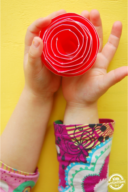This easy egg in vinegar science experiment is awesome and uses things that you already have at home. Kids can watch as a chemical reaction magically transforms an ordinary egg into a large naked egg through this egg science project that kids will love. This egg & vinegar experiment works great at home or in the classroom. Let’s make a Naked Egg!

Egg In Vinegar Experiment – Science for Kids
In science lessons, we are learning about the “building blocks of life” – aka Cells. We used this “naked egg” science project so the little scientist were able to identify cell parts by physically seeing, smelling, touching, and even tasting – ewwww!
Egg science projects like this naked egg in vinegar experiment have also been described as a rubber egg, bouncy egg or bouncing egg experiment.

Related: We had so much fun with this kids science experiment, it is part of our science book: 101 Coolest Simple Science Experiments for Kids!
There are a lot of different vinegar science experiments for kids and vinegar science projects, but this is definitely one of our favorites because it is super easy with surprising results.
This article contains affiliate links.
Vinegar Egg Science Experiment
The basics of this egg in vinegar experiment is that distilled vinegar is an acid with a pH around 2.6 based on the type or vinegar and is 5-8% acetic acid in water making it a weak acid which will break down the semi-permeable membrane shell of the egg which is comprised of calcium carbonate and then due to osmosis, the egg absorbs the liquid and will start to swell making it less fragile and a rubbery texture.
Supplies Needed for Rubber Egg Experiment

How to Make a Naked Egg – Science for Kids
1. Place the Egg in Vinegar
We took our egg and dropped it lightly into a jar of white vinegar solution (fresh vinegar) with some tongs. You will need enough vinegar to cover the egg(s) completely.
2. What Happens in 15 Minutes
After about 15 min it starts to bubble carbon dioxide gas because the calcium carbonate of the shell of an egg is breaking down. The little bubbles look just like when vinegar is dripped on baking soda.
Tip: To reduce the smell, add a top to your jar.
3. What Happens in 8 Hours
After about 8 hours the egg starts to spin as the gasses are released from the egg shell. It is so pretty to see the dancing egg.
Tip: Find a safe place to let your egg rest without direct sun, large swings in temperature (room temperature is best) or where it would be tipped over.

4. What Happens in 3 Days
After three days, your vinegar experiment will have a completely naked egg!
Parts of the egg shell will crack and dissolve in the acid over a couple of days and all that is left of your shell-less egg is an egg membrane.

Egg Shell Dissolves – Science for Kids
Once your egg has lost its shell, be very careful with it. The thin membrane is very soft and permeable. We actually broke on of the eggs in our experiment during out photo shoot.
The naked egg is so squishy and slimy feeling – your kids will love it! As they hold it, identify the parts of your egg. The egg’s membrane holds the egg together.
Comparing Results of Egg Experiment
We compared the membrane of the egg for:
- fresh egg or regular egg
- burst naked egg
- egg that was sitting in sugar water
The differences and similarities are astounding.
Look at how much bigger the egg is after it absorbed all the fluid.

Anatomy of An Egg: Cell Parts within the Naked Egg
The cell parts we found and identified:
- Nucleus – the command center or the brain of the cell. The cell nucleus is where RNA is replicated.
- Cytoplasm was easy to find, it is the egg white.
- In a chicken egg, the vacuole and Golgi bodies are inside the yolk.

Bouncy Egg Experiment
Take your naked eggs somewhere you can make a mess and systematically drop it onto a solid surface from higher and higher points to see how high your egg bounce is still bouncy and not squashed!
Several kids can work together to measure height for the drop or compete to see which of the bouncy eggs will survive the longest.
Deflating Egg Science Project
For another fascinating experiment, take the next step of placing your naked egg that is swollen with liquid into corn syrup and watch it deflate.
The opposite of osmosis will occur and the liquid will leave the cell, leaving a brownish shriveled egg due to concentration gradients.
So interesting to literally watch what eating too much sugar does to us! You can experiment with different liquids and how the egg swells and deflates depending on the acid-base reaction.
Egg in Vinegar Experiment

This simple naked egg science experiment is an easy egg in vinegar experiment using very simple supplies. Over several days kids will learn about how vinegar which is a weak acid will dissolve the eggshell and leave a rubbery bouncing egg that is swollen through the process of osmosis.
Materials
- Egg
- Vinegar
Tools
- Jar – we used a mason jar but a tall glass would work too
- Tongs or Spoon
Instructions
- Place the egg or eggs into a jar or glass and cover with vinegar solution.
- Watch what happens in 15 minutes when the carbon dioxide bubbles start breaking down the eggshell.
- Watch what happens in 8 hours when the egg starts to spin due to the carbon dioxide gasses being released creating a dancing egg.
- Watch what happens in 3 days where the eggshell dissolved fully.
- Inspect your naked egg and do other experiments on the resulting rubber egg to explore science concepts.
Grab Our Science Book for Kids

The 101 Coolest Simple Science Experiments for Kids is full of easy science play and fun science activities for everyone! You can pick this book packed with STEM activities at your local bookstore or online
Related: Make a battery train
More Science Activities & Fun from Kids Activities Blog
This naked egg experiment is a great way to for kids to see science at work first hand. For more favorite science experiments for kids, check out these other ideas:
- If your egg is still intact, then check out these egg drop ideas for kids!
- Have you ever tried to break an egg with one hand? It is a fun science experiment you can easily do at home!
- Have you ever wondered how to know whether an egg is boiled? It can be more science than guess!
- Bacteria experiment ideas for kids
- Did you know you could make egg yolk paint?
- Have you ever tried the rotten pumpkin science experiment
- Science Experiment with Baking Soda and Vinegar
- Science for Kids: How to Make a Balance
- Check out these fun Dr Seuss science activities for kids
- We have over 50 ideas for scientific games for kids to play and learn science.
- Need science fair project ideas? We got ’em!
- You can find more science experiments for kids here <–Over 100 ideas!
- And a whole lot of learning activities for kids here <–Over 500 ideas!
How did your egg in vinegar experiment turn out? Did your kids have patience to wait for eggshell dissolves fully?






















Lots of people shall be benefited out of your writing.
Awesome ideas for kids science.
I actually did this with my kids after a friend brought one she did over during hers she added red food coloring so you could actually see the veins… It also bounced when dropped from 2-3 inches off the counter although the smell is not pleasant it was fun
I’m guessing you use a cooked egg before you drop the egg with the shell on in vinegar?
Superb, my high school students will love trying this as a science project this year.
Way cool!
I can’t wait for my daughter to try this for her science project! So cool!!!
Hi there, I discovered your site by the use of Google for vinegar and egg experiment. So glad I did!
This article is great. Thanks!